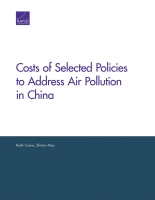| 来源类型 | Research Reports
|
| 规范类型 | 报告
|
| DOI | https://doi.org/10.7249/RR861
|
| 来源ID | RR-861-TI
|
| Costs of Selected Policies to Address Air Pollution in China |
| Keith Crane; Zhimin Mao
|
| 发表日期 | 2015
|
| 出版年 | 2015
|
| 页码 | 40
|
| 语种 | 英语
|
| 结论 |
China Must Address Its Air-Pollution Problem, and Soon- Concentrations of pollutants exceed standards recommended by the World Health Organization (WHO) in virtually every major urban area in China.
- The large costs of air pollution are driven by health impacts and loss of productivity, running 6.5 percent of China's gross domestic product (GDP) each year between 2000 and 2010, and rising as China's population becomes more urbanized and productive.
- The Chinese government will need to not only enforce existing anti-pollution regulations much more aggressively, but also substitute other sources of energy for coal to achieve substantial reductions in air pollution.
Three Main Approaches Can Be Taken to Improve Air Quality- For China's cities to meet WHO standards for air quality, the burning of coal, biomass, and plastic wastes in urban areas by residential and commercial users will have to stop.
- To reach healthy air quality levels, China will have to replace a substantial amount of coal-fired electric power, especially in or near major population centers, with generation from power plants that use other, less-polluting fuels, such as natural gas, nuclear, wind, or solar.
- Motor vehicles have been a rapidly rising source of air pollution in China, especially emissions of nitrogen oxides. China has been addressing this problem by adopting and enforcing the more stringent air pollution standards of the European Union. Scrapping highly polluting vehicles that have remained on China's highways is the most efficient way to reduce air pollution from motor vehicles already on the road.
These Measures Come at a Cost- Replacing coal with natural gas for residential and commercial heating could run $32 billion to $52 billion.
- Replacing half of China's coal-fired electric power generation with renewables or nuclear power could cost $184 billion.
- Implementing limited buyback programs of old vehicles to get them off the road would be of relatively short duration; and could run $21 billion to $42 billion.
- However, given that the health costs of current air pollution run 6.5 percent of China's GPD (approximately $535 billion in 2012), improved air and economic output could offset these costs.
|
| 摘要 |
- The near-term priority should be substituting natural gas for coal for residential and commercial use. Boilers and stoves fueled by coal, wood, or wastes are notorious for emitting pollution. Ending the use of these fuels would substantially improve air quality in urban areas, especially in winter months, greatly reducing the number of days when air quality is extremely bad.
- Replacing coal-fired power with other sources of energy is the most expensive policy measure of the three we evaluate, and would contribute most to reducing overall emissions of total suspended particulates (TSP) and sulfur dioxide in China. However, its impact on urban air quality might not be as great as suggested by the expected decline in emissions. Thus, it should be the second-highest priority of the three options examined.
|
| 主题 | Alternative and Renewable Energy
; China
; Environmental Pollution
; Environmental Regulation
; Natural Gas
|
| URL | https://www.rand.org/pubs/research_reports/RR861.html
|
| 来源智库 | RAND Corporation (United States)
|
| 引用统计 |
|
| 资源类型 | 智库出版物
|
| 条目标识符 | http://119.78.100.153/handle/2XGU8XDN/107906
|
推荐引用方式
GB/T 7714 |
Keith Crane,Zhimin Mao. Costs of Selected Policies to Address Air Pollution in China. 2015.
|
|
文件名:
|
1535045926143.jpg
|
|
格式:
|
JPEG
|

|
文件名:
|
RAND_RR861.pdf
|
|
格式:
|
Adobe PDF
|
除非特别说明,本系统中所有内容都受版权保护,并保留所有权利。